#A. labiculata
Explore tagged Tumblr posts
Text
Propylea quatuordecimpunctata, fourteen-spotted lady beetle
Anatis labiculata, fifteen-spotted lady beetle
Coleomegilla maculata, pink spotted lady beetle or twelve-spotted lady beetle
Last one may be Halmus chalybeus, steelblue lady beetle (which is also subfamily Chilocorinae)
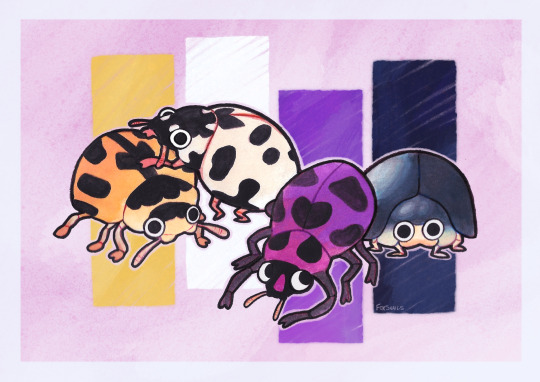
Non-binary flag made from ladybugs! (And one lady beetle)
Watercolour, gouache and Procreate
Commission Info
#art#stylized#not my id#Propylea#P. quatuordecimpunctata#Anatis#A. labiculata#Coleomegilla#C. maculata#Chilocorus#Halmus#H. chalybeus#foxsnails
878 notes
·
View notes
Text


parkcalmenoir!
parkcalmenoir; a lumenoir gender connected to amusement parks, picnics, later winter/early spring, rebirth, a. labiculata bugs, oranges, feelings of calm, & choosing happiness!

for; anon!
etymology; park, calm, (lum)enoir
symbol source (link)
tagging; @radiomogai, @thecoffeecrew404

19 notes
·
View notes
Text
Species Masterpost
A list of the species that have been featured on this blog so far! Work in progress.
A
Adalia - x
Adalia bipunctata - x - 2 spotted
Adalia decempunctata - x - 10 spotted
Anatis - x
Anatis labiculata - x - 15 spotted
Anatis mali - x - eye spotted (american)
Anatis ocellata - x - eyed (european)
Anatis rathvoni - x - flying saucer
Anisosticta
Anisosticta novemdecimpunctata
Aiolocaria
Aiolocaria hexaspilota
Apolinus - x
Apolinus lividigaster - x - yellow shouldered
Azya - x
Azya orbigera - x
B
Brachiacantha - x
Brachiacantha arizonica - x
Brachiacantha ursina - x
Brumoides
Brumoides ohtai
C
Calvia - x
Calvia albida - x
Calvia decemguttata - little arboreal
Calvia muiri
Calvia quatuordecimguttata - cream spotted
Ceratomegilla
Ceratomegilla notata
see also: Hippodamia notata - x
Cheilomenes - x
Cheilomenes bidentata - x
Cheilomenes lunata - x - lunate
Cheilomenes sexmaculata - x - 6 spotted zigzag
Chilocorus
Chilocorus kuwanae - Kuwana's lady beetle
Chilocorus nigritus - Malaysian ladybird beetle
Chilocorus rubidus
Coccinella - common lady beetles - x
Coccinella leonina - orange spotted - x
Coccinella monticola - x - mountain
Coccinella novemnotata - 9 spot - x
Coccinella septempunctata - 7 spot - x
Coccinella transversalis - x - transverse lady
Coccinella trifasciata - x - 3 banded lady
Coccinula - x
Coccinula quatuordecimpustulata - x
Coelophora - x
Coelophora inaequalis - x - seaside
Coleomegilla - x
Coleomegilla maculata - x - pink spotted
Cryptolaemus - x
Cryptolaemus montrouzieri
Curinus - x
Curinus coeruleus - x
Cycloneda - spotless lady beetles - x
Cycloneda emarginata - x
Cycloneda munda - x
Cycloneda polita - x
Cycloneda pulchella - x
Cycloneda sanguinea - spotless lady beetle - x
D
Declivitata - x
Declivitata olivieri - x
E
Epilachnini - x - leaf eating (tribe)
Epilachna - x
Epilachna borealis - x - squash beetle
Epilachna vigintisexpunctata
Exochomus - x
Exochomus quadripustulatus - x - pine ladybird
F
G
H
Halmus - x
Halmus chalybeus - x - steelblue lady beetle
Halyzia
Halyzia sedecimguttata - orange ladybird
Henosepilachna - x
Henosepilachna argus - x
Henosepilachna vigintioctopunctata - x
see also: Epilachnini - x
Harmonia - x
Harmonia axyridis - x
Harmonia conformis - x
Harmonia testudinaria - x
Hippodamia - oblong lady beetles - x
Hippodamia americana - x
Hippodamia apicalis - x
Hippodamia convergens - convergent lady beetle - x
Hippodamia hieroglyphica - x
Hippodamia notata - x
Hippodamia oregonensis - x
Hippodamia parenthesis - x
Hippodamia quinquesignata - 5 spotted lady beetle - x
Hippodamia tredecimpunctata - 13 spotted lady beetle - x
Hippodamia variegata - variegated lady beetle - x
I
Illeis
Illeis galbula
J
K
L
M
Mulsantina - x
Mulsantina picta - x
N
Naemia - x
Naemia seriata - x
Novius - x
Novius bellus
Novius cardinalis - x
Novius circumclusus
Novius fumidus
Novius iceryae
Novius koebelei
Novius virginalis
O
Oenopia - x
Oenopia lyncea - x
P
Papuaepilachna - x
Papuaepilachna guttatopustulata - x
see also: Epilachnini - x
Paranaemia - x
Paranaemia vittigera - x
Propylea
Propylea japonica
Propylea quatuordecimpunctata
Psyllobora - fungus-eating lady beetles - x
Psyllobora borealis - western fairy ladybird - x
Psyllobora lata - x
Psyllobora nigrovittata - x
Psyllobora picta - x
Psyllobora renifer - kidney spotted - x
Psyllobora roei - x
Psyllobora vigintiduopunctata - 22 spot ladybird - x
Psyllobora vigintimaculata - 20 spot ladybird - x
Q
R
S
Scymninae (subfamily)
Scymnini (tribe)
Scymnus - x
T
U
V
W
X
Y
Z
Non ladybugs
All can be found under tag #not a ladybug
Beetles
Coleoptera - x
Chrysomelidae - x
Aspidimorpha miliaris
Leptinotarsa decemlineata
Crioceris duodecimpunctata
Endomychus coccineus
Spiders
Araneae - x
Eresus - x
Eresus sandaliatus
Paraplectana thorntoni
Mammals
Bos taurus
Felis catus
4 notes
·
View notes
Text
Back on my hyperfixation shenanigans so I have not slept and here's a list of what I consider to be the prettiest beetles, butterflies and moths, damselflies, and grasshoppers and crickets that inhabit Colorado and Kentucky according to insectidentification.org :
COLORADO
Emerald ash borer (Agrilus planipennis)
Fifteen-spotted lady beetle (Anatis labiculata)
Golden tortoise beetle (Charidotella sexpunctata)
Knapweed root weevil (Cyphocleonus achates)
Longhorn beetle (Semanotus amethystinus)
Dogbane Leaf Beetle (Chrysochus auratus)
European Ground Beetle (Carabus nemoralis)
Golden Net-wing Beetle (Dictyoptera aurora)?
Margined Blister Beetle (Epicauta funebris)
May Beetle - P. lanceolata (Phyllophaga lanceolata)
Mottled Tortoise Beetle (Deloyala guttata)
Pleasing Fungus Beetle (Gibbifer californicus)
Poplar Borer Beetle (Saperda calcarata)
Shining Leaf Chafer - Anomala spp. (Anomala spp.)
Signate Lady Beetle (Hyperaspis signata)
American Lappet Moth (Phyllodesma americana)
Cinnabar Moth (Tyria jacobaeae)
Common Checkered-Skipper (Pyrgus communis)
Glover's Silkmoth (Hyalophora columbia gloveri)
Great Ash Sphinx Moth (Sphinx chersis)
Autumn Meadowhawk (Sympetrum vicinum)
Black Saddlebags Skimmer (Tramea lacerata)
Bird Grasshopper (Schistocerca spp.)
Obscure Bird Grasshopper (Schistocerca obscura)
Sooty Longwing Katydid (Capnobotes fulginosus)
KENTUCKY
Andrew's Snail-eating Beetle (Scaphinotus andrewsii)
Black Firefly (Lucidota atra)
Calligrapha Beetle (Calligrapha spp)
Eastern Hercules Beetle (Dynastes tityus)
Emerald Euphoria Beetle (Euphoria fulgida)
Glowworm (Phengodes spp.)
Goldsmith Beetle (Cotalpa lanigera)
Metallic Wood-boring Beetle: Chalcophora (Chalcophora fortis)
Notched-mouth Ground Beetle (Dicaelus purpuratus)
One-spotted Tiger Beetle (Apterodela unipuncata)
Rainbow Darkling Beetle (Tarpela micans)
Rainbow Scarab Beetle (Phanaeus vindex)
Six-spotted Tiger Beetle (Cicindela sexguttata)
Southern Sculptured Pine Borer Beetle (Chalcophora georgiana)
Stag Beetle (Lucanus capreolus)
Twice-stabbed Lady Beetle (Chilocorus stigma)
Vietinghoff's Ground Beetle (Carabus vietinghoffii)
Abbott's Sphinx Moth (Sphecodina abbottii)
American Ermine Moth (Yponomeuta multipunctella)
Arched Hooktip (Drepana arcuata)
American Bird's-Wing Moth (Dypterygia rozmani)
Arcigera Flower Moth (Schinia arcigera)
Attentive Crocus Moth (Xanthotype attenuaria)
Basswood Leafroller (Pantographa limata)
Beautiful Wood-Nymph (Eudryas grata)
Black-waved Flannel Moth (Megalopyge crispata)
Blackberry Looper (Chlorochlamys chloroleucaria
Blinded Sphinx Moth (Paonias excaecata)
Bluish Spring Moth (Lomographa semiclarata
Buck Moth (Hemileuca maia)
Carmine Snout Moth (Peoria approximella)
Carrot Seed Moth (Sitochroa palealis)
Cecropia Silk Moth (Hyalophora cecropia)
Changeable Grass-Veneer (Fissicrambus mutabilis)
Colorful Zale (Zale minerea)
Common Lytrosis Moth (Lytrosis unitaria)
Confused Eusarca (Eusarca confusaria)
Cross-lined Wave (Timandra amaturaria)
Curve-toothed Geometer (Eutrapela clemataria)
Dark-banded Geometer (Ecliptopera atricolorata)
Deep Yellow Euchlaena (Euchlaena amoenaria)
Diaphania costata (Diaphania costata
Dimorphic Macalla (Epipaschia superatalis)
Dot-lined White (Artace cribrarius)
Dotted Gray (Glena cribrataria)
Drab Prominent (Misogada unicolor)
Eight-spotted Forester Moth (Alypia octomaculata)
Elder Shoot Borer (Achatodes zeae)
Explicit Arches (Lacinipolia explicata)
Eyed Paectes Moth (Paectes oculatrix)
Falcate Orangetip (Anthocharis midea) (female)
Fall Webworm (Hyphantria cunea)
False Crocus Geometer (Xanthotype urticaria
Fervid Plagodis (Plagodis fervidaria)
Fig Sphinx (Pachylia ficus)
Friendly Probole Moth (Probole amicaria)
Giant Leopard Moth (Hypercompe scribonia)
Goldcap Moss-eater Moth (Epimartyria auricrinella)
Gray-edged Hypena (Hypena madefactalis)
Green Arches (Anaplectoides prasina)
Hag Moth (Phobetron pithecium
Hibiscus Leaf Caterpillar Moth (Rusicada privata)
Imperial Moth (Eacles imperialis)
Lesser Maple Spanworm Moth (Speranza pustularia
Luna Moth (Actias luna)
Melissa Blue Butterfly (Plebejus melissa spp.)
Modest Sphinx Moth (Pachysphinx modesta)
Morbid Owlet Moth (Chytolita morbidalis)
Orange-patched Smoky Moth (Pyromorpha dimidiata)
Pale Beauty (Campaea perlata)
Pale Lichen Moth��(Crambidia pallida)
Pale Metarranthis (Metarranthis indeclinata)
Pandorus Sphinx Moth (Eumorpha pandorus)
Parthenice Tiger Moth (Apantesis parthenice)
Pearly Wood-Nymph Moth (Eudryas unio)
Pero Moth (Pero spp.)
Pink-patched Looper (Eosphoropteryx thyatyroides)
Pipevine Swallowtail (Battus philenor)
Pistachio Emerald Moth (Hethemia pistasciaria)
Plebeian Sphinx Moth (Paratrea plebeja) (Caterpillar)
Primrose Moth (Schinia florida)
Promiscuous Angle Moth (Macaria promiscuata)
Raspberry Pyrausta (Pyrausta signatalis)
Rustic Sphinx Moth (Manduca rustica)
Saddleback Caterpillar Moth (Acharia stimulea)
Saddled Yellowhorn (Colocasia flavicornis)
Salt-and-pepper Looper Moth (Syngrapha rectangula)
Satin Moth (Leucoma salicis)
Scarlet-winged Lichen Moth (Hypoprepia miniata)
Schlaeger's Fruitworm Moth (Antaeotricha schlaegeri)
Showy Emerald Moth (Dichorda iridaria)
Small Bird Dropping Moth (Ponometia erastrioides)
Snowy Urola (Urola nivalis)
Sorghum Webworm Moth (Nola cereella)
Southern Flannel Moth (Megalopyge opercularis)
Southern Longhorn Moth (Adela caeruleella)
Southern Pine Sphinx (Lapara coniferarum)
Southern Tussock Moth (Dasychira meridionalis)
The Badwing (Dyspteris abortivaria)
Unspotted Looper Moth (Allagrapha aerea)
Venerable Dart Moth (Agrotis venerabilis
Vine Sphinx Moth (Eumorpha vitis)
Walnut Sphinx Moth (Amorpha juglandis)
Wavy-lined Emerald Moth (Synchlora aerata)
Western Grapeleaf Skeletonizer Moth (Harrisina metallica)
White Flannel Moth (Norape ovina)
White Slant-line Moth (Tetracis cachexiata)
White-fringed Emerald Moth (Nemoria mimosaria)
Yucca Moth (Tegeticula, Greya, and Prodoxus spp.)
Carolina Locust (Dissosteira carolina)
Eastern Shieldback Katydid (Atlanticus spp.)
Slender Meadow Katydid (Conocephalus fasciatus)
True Katydid (Pterophylla camellifolia)
Ebony Jewelwing (Calopteryx maculata)
Midland Clubtail (Gomphurus fraternus)
Red Saddlebags (Tramea onusta)
Seepage Dancer (Argia bipunctulata)
5 notes
·
View notes
Photo
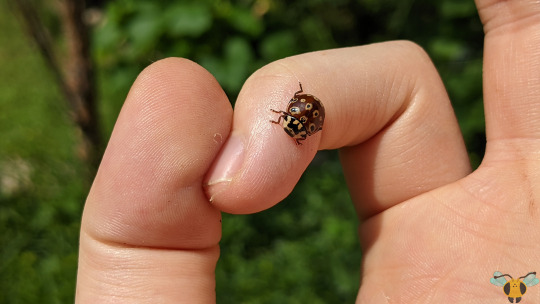

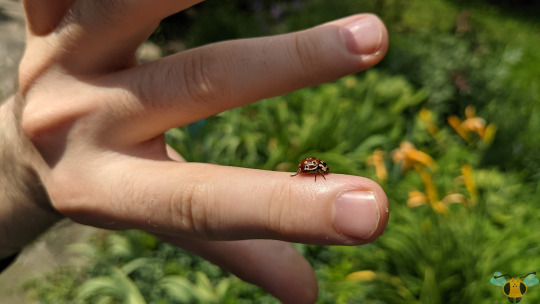


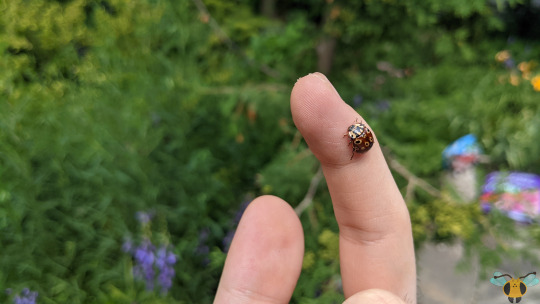
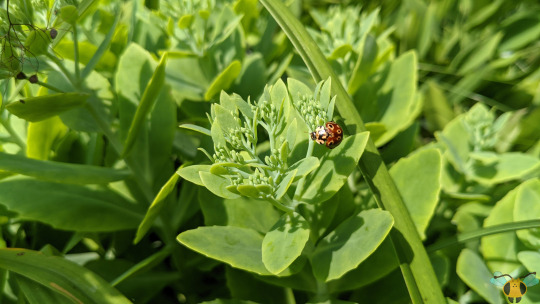


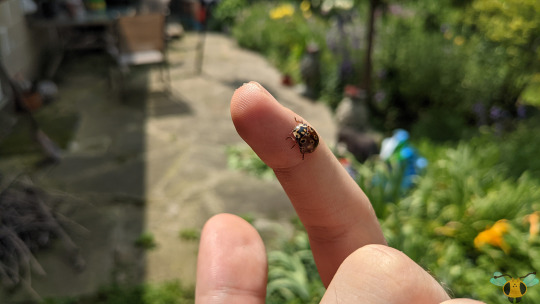
Eye-Spotted Ladybug - Anatis mali
Since they come in all sorts of patterns and sizes, when identifying Ladybugs it’s important you carefully observe every detail as best you can. Important details to check are the spot number, spot position and the thorax pattern. The Asian Ladybug for example have a multitude of patterns on their shell (it’s quite impressive the sheer variety) but most of them can be verifying by the black “W” shaped marking on the thorax. How convenient! As you can guess by the title of this post, this insect is not an Asian Ladybug. It’s large size and rimmed spots suggest that, but if you look at the thorax too you can be 100% sure. There’s a black “W” pattern there too, but it doesn’t match the Asian Ladybug’s pattern; it’s much bolder, especially the inner white curves. Combine everything together, we have a new specie for this blog: The Eye-Spotted Ladybug or the American Eyespot Ladybug (so as not to confuse it with a European relative). Those spots with rings around them give this little jellybean its name. For those of us living in Toronto and those in the Eastern United States near Toronto, be very attentive when identifying your Anatis genus Ladybugs. These giants (relatively speaking) are noted to have variable colors, some darkened to match even their spot color in some cases! This could be identification and cataloguing very difficult.
The darker forms of Eye-Spot can be mistaken for the 15-Spotted Ladybug (A. labiculata) at a first glance as the rings may be obscured by the dark shell. In the grand scheme of things it may not be so critical, but for the purposes of establishing ranges and species interaction mistaking one insect for another might be confusing. Check the spots and thorax as best you can. Pick them up and get a close up look. This one seemed rather thrilled to crawl on my hand as it started to nibble me, possibly for some salt or loose skin. Though it can be tough to see, this Ladybug has large mandibles to match its large size, so the feeling is definitely of a nibble and less a tickle. Fear not, they cannot puncture skin, preferring to feed on soft-bodied insects such as Aphids. These Ladybugs seem to specialize of treetop Aphids, rarely venturing to lower levels in search of food (so I wonder what this one was doing here?) making them valuable in contributing to good tree health. Their large size means they have access to food sources other Ladybugs would dare not try to catch. Some have even been seen eating arboreal Caterpillars and Sawfly larvae as well (especially the Ladybug larvae). When you’re huge and built like a 6-legged spiked alligator or a teardrop/helmet-shaped armored tank, soft-bodied insects are no challenge at all.
Pictures were taken on July 15, 2021 with a Google Pixel 4.
#jonny’s insect catalogue#insect#beetle#eye spotted ladybug#ladybug#coleoptera#toronto#july2021#2021#ontario insect#entomology#nature#ladybird beetle#invertebrates#arthropods#photography#animals
6 notes
·
View notes
Photo

Anatis labiculata (Coleoptera : Coccinellidae) the 15 spotted lady beetle. This genus is often called the "giant lady beetles" and for good reason! This is by far the largest I have ever seen (at Trexler Nature Preserve)
10 notes
·
View notes
Note
may I request the following genders:
a deurseity gender related to silver foxes, golden dragonflies, whale skeleton lanterns, serpents, Monster Energy drinks, green & gold marble, and this image: (https://i.pinimg.com/564x/ae/4d/d7/ae4dd7f01ae03468f69fa9c69c0eb995.jpg),
a TROPiN gender related to beagles, clear ocean water, aloe vera, palm fronds, ferns, pineapples, coral reefs & tropical fish, beaches, waterfalls, and Tropical aesthetics,
an everithe gender related to pine martens, cassette tape, sunset meadows, flowering tea, flowers in ice, and evergreen trees,
wilderic gender related to diamond vests, Pekin ducks, lily pads & sunsets, ponds, abandoned greenhouses, matcha, the Manhattan Toy Voyagers Stomp Dino, and the painting Allotments by David Inshaw,
lumenoir gender related to amusement parks, picnics, late winter/early spring, rebirth, A. labiculata bugs, oranges, feelings of calm, and choosing happiness
aneastian gender related to black ravens & white ravens, red albino eyes, black and white pictures, red disco balls, white butterflies, the colours #890e07, #080806, and #e9e3dc, bass guitars, crimson roses, impressionist paintings, melancholy and being asocial
xenogender related to arctic foxes, pink rhodotus mushrooms, ball pythons, soft knitted wool, witch hats, bubbling cauldrons, strawberry moons, enchanted tea, rat skulls, the colours #e9bcc6, #822f4d, #5e2c42, & #491d23, and being a Bubblegum Witch?
Thank you!!
all queued!
2 notes
·
View notes
Note
inbox check? (cant remember if i rqed from.u alr 🥲)
here's all of our current reqs (link)! & here's what our inbox is currently showing us (know for a fact it's not showing us all our asks </3)
Daisy, Whiskey, Rose, Mildew, Allspice, Ash, New Shoe Smell, Toxic Chemicals, Sandalwood, Paint, Chamomile, Gingerbread, Candy Corn, Green Apple, Cologne, Spearmint, Fresh Linen, and a floral + fruity scent
a deurseity gender related to silver foxes, golden dragonflies, whale skeleton lanterns, serpents, Monster Energy drinks, green & gold marble, and this image: (https://i.pinimg.com/564x/ae/4d/d7/ae4dd7f01ae03468f69fa9c69c0eb995.jpg)
a TROPiN gender related to beagles, clear ocean water, aloe vera, palm fronds, ferns, pineapples, coral reefs & tropical fish, beaches, waterfalls, and Tropical aesthetics
an everithe gender related to pine martens, cassette tape, sunset meadows, flowering tea, flowers in ice, and evergreen trees
wilderic gender related to diamond vests, Pekin ducks, lily pads & sunsets, ponds, abandoned greenhouses, matcha, the Manhattan Toy Voyagers Stomp Dino, and the painting Allotments by David Inshaw
lumenoir gender related to amusement parks, picnics, late winter/early spring, rebirth, A. labiculata bugs, oranges, feelings of calm, and choosing happiness
aneastian gender related to black ravens & white ravens, red albino eyes, black and white pictures, red disco balls, white butterflies, the colours #890e07, #080806, and #e9e3dc, bass guitars, crimson roses, impressionist paintings, melancholy and being asocial
xenogender related to arctic foxes, pink rhodotus mushrooms, ball pythons, soft knitted wool, witch hats, bubbling cauldrons, strawberry moons, enchanted tea, rat skulls, the colours #e9bcc6, #822f4d, #5e2c42, & #491d23, and being a Bubblegum Witch
scene and emo genderqueer
an aesthetigender based on the animal crossing new horizons aquarium
bi-dynamic of xi and iota
mint chocolate scent
sweet liquor/bourbon soaked cherries and vanilla scent
Camp Maker & a Colony Maker
beta leaning & alpha leaning
4 notes
·
View notes
Text
From left to right: (near as I can tell, anyway)
Propylea quatuordecimpunctata
Anatis labiculata
Coleomegilla maculata
Something from the subfamily chilocorinae, maybe Chilocorus nigritus?
All are members of the beetle family Coccinellidae- so all are Lady Beetles. Ladybug is just a term that shows up in the common names of a lot of different species within the family!

Non-binary flag made from ladybugs! (And one lady beetle)
Watercolour, gouache and Procreate
Commission Info
878 notes
·
View notes